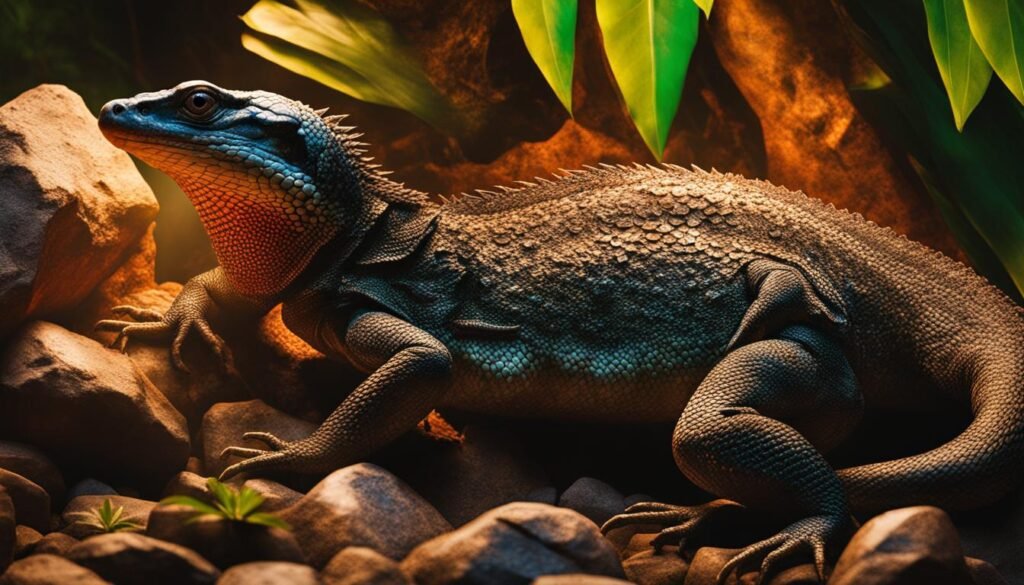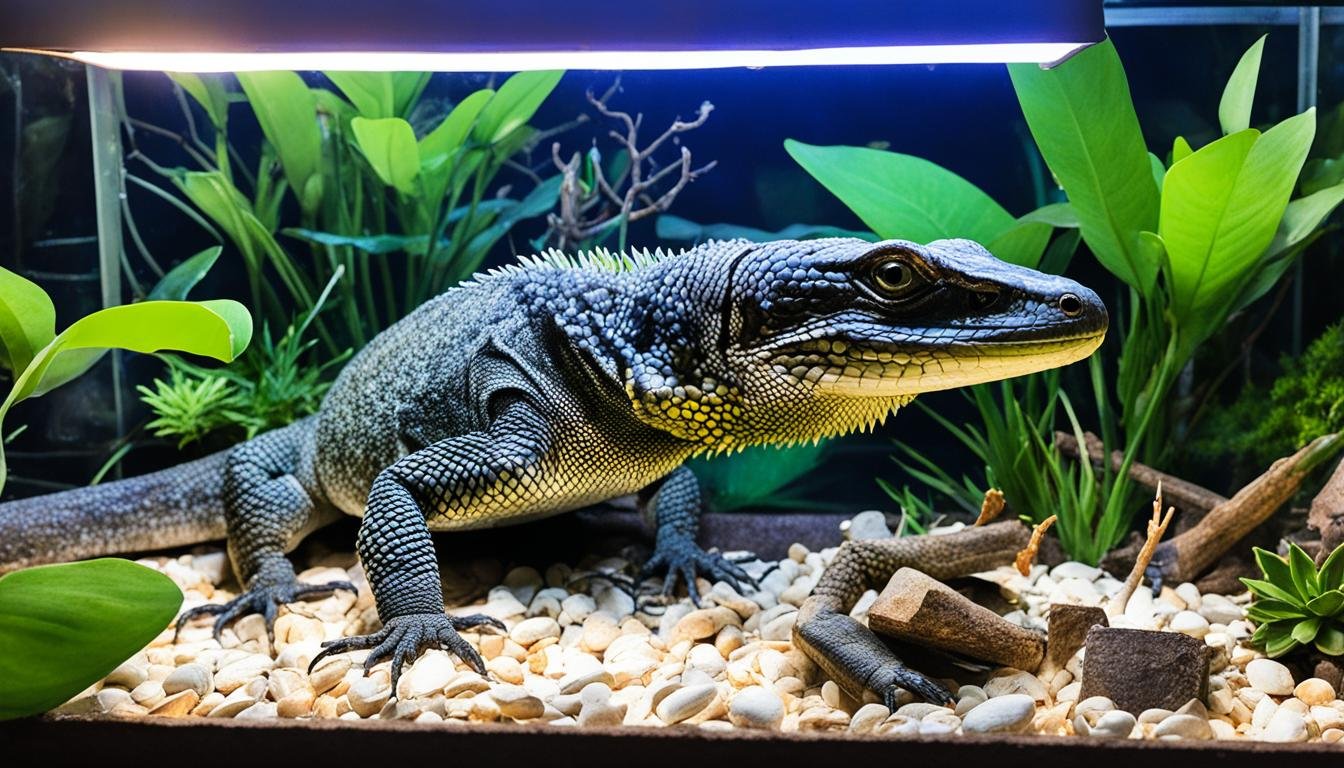Did you know that monitor lizards are among the most popular reptile pets in the world? These fascinating creatures, with their exotic appearance and tropical charm, have captivated the hearts of reptile enthusiasts everywhere. But caring for a monitor lizard requires more than just admiration. From understanding their habitat requirements to knowing their feeding habits and behavior traits, proper care is vital for ensuring a happy and healthy life for your monitor lizard pet.
Key Takeaways:
- Monitor lizards are popular reptile pets known for their exotic appearance and tropical charm.
- Proper care is essential for the well-being of monitor lizards, including habitat setup, feeding and nutrition, lighting, and regular veterinary care.
- Choosing the right monitor lizard species is crucial, considering factors such as temperament, size, and care needs.
- Monitor lizards have diverse feeding habits and can eat insects, rodents, birds, and other small animals. Calcium supplementation is necessary for proper bone health.
- Understanding the behavior traits of monitor lizards helps in providing appropriate environmental enrichment and handling techniques.
Understanding Monitor Lizards: Facts and Figures
Monitor lizards are fascinating creatures that are indigenous to Africa, Asia, Australia, and Indonesia. They have adapted to various habitats, including deserts, forests, and savannahs, showcasing their incredible resilience and versatility. These reptiles come in different sizes, with some measuring less than a foot long, while others can reach lengths of over six feet. Let’s delve into the intriguing details about monitor lizards, from their habitats to their predatory nature.
Indigenous Habitats
Monitor lizards are known for their adaptability and can be found in diverse habitats across the world. Here are some of the regions where they are commonly found:
- Africa
- Asia
- Australia
- Indonesia
These varied environments include deserts, forests, and savannahs, reflecting the wide range of conditions in which monitor lizards thrive.
Varying Sizes
The size of monitor lizards can vary significantly. While smaller species can be as tiny as a foot long, larger ones can reach astonishing lengths of over six feet. This size diversity is a testament to the remarkable adaptability of monitor lizards across different environments.
Predators and Scavengers
Monitor lizards are skilled predators renowned for their hunting capabilities. Their diet consists of a wide array of prey, including:
- Insects
- Birds
- Rodents
- Fish
- Frogs
- Carrion
These reptiles are not only successful predators, but they also scavenge for food, making the most of available resources in their habitats.
Now that we have gained some insights into the natural habitat, size, and feeding habits of monitor lizards, it’s important to explore their temperament and behavior traits in order to understand and appreciate these incredible creatures even more.
Choosing the Right Monitor Lizard Species
When considering a monitor lizard as a pet, it’s essential to research and select the species that best suits your preferences and experience. There are various monitor lizard species available, each with its own unique temperament, price range, and size. By understanding the characteristics of different species, you can make an informed decision that ensures a harmonious bond with your pet.
Temperament: Monitor lizards exhibit a wide range of temperaments. Some species, such as the savannah monitor, are known for their gentle and sociable nature, making them suitable for first-time lizard owners. On the other hand, species like the Nile monitor can be more aggressive and require experienced handlers. Consider your comfort level with each species’ temperament before making a choice.
Price: The price of monitor lizard species can vary significantly. Generally, species that are readily available and easier to breed tend to be more affordable. For example, the savannah monitor is a popular and relatively inexpensive species to acquire. In contrast, rarer and more exotic species like the blackthroat monitor may have a higher price tag. Determine your budget and consider the long-term costs of owning a particular species.
Size: Monitor lizards come in a wide range of sizes. Some species, like the Timor monitor, reach an adult length of only 2-3 feet, making them suitable for those with limited space. Others, such as the Asian water monitor, can grow up to 9 feet in length and require more substantial enclosures. Consider the size of the species and how it aligns with the available space you have for your pet.
Habitat Setup for Monitor Lizards
Providing a suitable habitat is crucial for the well-being of your monitor lizard. The habitat should be designed to meet the specific needs of these fascinating reptiles, including factors like enclosure size, climbing opportunities, temperature regulation, and humidity control.
Enclosure Size
The size of the enclosure is an essential consideration when setting up a habitat for a monitor lizard. It should be spacious enough to accommodate the species comfortably and allow for future growth. Larger species may require custom-made enclosures to provide ample space for their active lifestyle.
Climbing Opportunities
Monitor lizards are natural climbers and need a habitat that offers plenty of climbing opportunities. Providing sturdy branches, logs, and rocks within the enclosure allows them to exercise their climbing instincts and promotes their overall physical and mental well-being.
Temperature Regulation
Proper temperature regulation is crucial for monitor lizards’ health and digestion. It’s important to create a thermal gradient within the habitat, with a warm basking spot and a cooler area for thermoregulation. Different species have different temperature requirements, so adequate research is necessary to provide the optimal temperature range.
Humidity Control
Monitor lizards thrive in environments with specific humidity levels. It’s important to monitor and control humidity to mimic their natural habitat accurately. Some species require higher humidity levels, while others prefer drier conditions. Using a hygrometer and misting the enclosure regularly can help maintain the ideal humidity levels.
Substrate Options
The choice of substrate is another crucial factor in creating a suitable lizard habitat. A mixture of potting soil and cypress bark can be used as a substrate, as it mimics the natural environment of the lizard. This substrate provides the necessary burrowing opportunities and retains moisture for maintaining humidity levels.
| Aspect | Considerations |
|---|---|
| Enclosure Size | Depends on the species and future growth |
| Climbing Opportunities | Provide branches, logs, and rocks for climbing |
| Temperature Regulation | Create a thermal gradient with a warm basking spot |
| Humidity Control | Monitor humidity levels and mist the enclosure |
| Substrate Options | Mixture of potting soil and cypress bark |
Feeding and Nutrition for Monitor Lizards

Feeding monitor lizards requires careful consideration of their carnivorous nature and specific dietary needs. These reptiles thrive on a diet consisting of a variety of prey items, which include insects, rodents, birds, and other small animals. Proper nutrition plays a vital role in their overall health and well-being.
When determining the feeding schedule for your monitor lizard, it’s essential to take into account factors such as the age and size of the lizard. Juveniles typically require more frequent meals, while adult lizards can be fed less often. Establishing a consistent feeding routine helps maintain their digestive system and promotes healthy growth.
To ensure optimal nutrition, it is important to gut-load the insects before offering them to your monitor lizard. Gut-loading refers to feeding the insects a nutritious diet for a period of time before they become part of your lizard’s meal. This process increases the nutritional value of the prey items, providing essential vitamins and minerals.
Calcium supplementation is crucial for monitor lizards, as it helps maintain proper bone health. These reptiles rely on calcium to support their skeletal structure and prevent metabolic bone disease. Calcium powder can be dusted onto prey items or mixed with other supplements to ensure the lizard receives the necessary amount.
| Prey Items | Benefits |
|---|---|
| Insects | Provide essential protein and nutrients |
| Rodents | Offer a balanced diet and natural prey for larger species |
| Birds | Rich in protein and offer variety in the diet |
| Other small animals | Introduce diversity and natural prey options |
Remember to consult with a reptile veterinarian or experienced reptile owner for specific feeding recommendations based on the species of monitor lizard you own. They can provide you with valuable insights and guidance in ensuring your lizard receives the proper nutrition it needs for a healthy and thriving life.
Lighting and Environmental Needs

Proper lighting is essential for the health and well-being of monitor lizards, just like other reptiles. UVB lighting plays a crucial role in their overall development, as it helps them synthesize Vitamin D3, which is necessary for calcium absorption. To mimic the sun’s natural rays, it’s recommended to provide UVB lighting for at least eight hours daily. This can be achieved through specialized UVB bulbs designed for reptiles.
Temperature regulation is another important aspect of monitor lizard care. These reptiles require a basking spot where they can comfortably raise their body temperature to the appropriate level for their species. This basking area should reach a temperature range of 100-110°F (38-43°C). A heat lamp or ceramic heat emitter can be used to provide the necessary warmth.
Humidity levels are also crucial for monitor lizards, although they vary depending on the species. Some species, like the Asian water monitor, require higher humidity levels, while others, like the Savannah monitor, can tolerate lower humidity. It’s important to monitor and maintain the appropriate humidity levels by misting the enclosure regularly or using a humidifier, if necessary.
The enclosure should be designed to provide both warm and cool areas, allowing the lizard to thermoregulate according to its needs. This can be achieved by creating temperature gradients within the habitat, with the basking area being the warmest and the opposite end of the enclosure being cooler. Additionally, it’s essential to provide hiding spots and foliage to create a sense of security for the lizard.
Lighting and Environmental Needs Table
| Aspect of Care | Recommendations |
|---|---|
| UVB Lighting | Provide UVB lighting for at least eight hours daily to mimic the sun’s natural rays. Use specialized UVB bulbs designed for reptiles. |
| Temperature Regulation | Ensure a basking spot with temperatures reaching 100-110°F (38-43°C) using a heat lamp or ceramic heat emitter. |
| Humidity Levels | Maintain appropriate humidity levels based on the species. Some species require higher humidity, while others can tolerate lower levels. |
| Enclosure Design | Create temperature gradients within the enclosure, providing warm and cool areas, as well as hiding spots and foliage for security. |
Common Health Issues and Care
When it comes to monitor lizards, it’s important to be aware of common health issues that they may encounter. By understanding these issues and providing proper care, you can help ensure the well-being of your pet.
Parasitic Infections
Parasites are a common health concern for monitor lizards. They can be contracted from contaminated food or the environment. These parasites, such as ticks, mites, and worms, can cause various health problems and discomfort for your lizard. Regular veterinary check-ups and proper hygiene practices, including cleaning and disinfecting the enclosure, can help prevent and treat parasitic infections.
Respiratory Infections
Monitor lizards are susceptible to respiratory infections, which can be caused by bacteria or viruses. Symptoms may include difficulty breathing, wheezing, coughing, or nasal discharge. Respiratory infections can be caused by inappropriate habitat conditions, such as low temperatures or high humidity levels. It’s important to maintain the proper environmental conditions and promptly seek veterinary care if you suspect your lizard has a respiratory infection.
Metabolic Bone Disease
Metabolic bone disease is a serious health condition that can affect monitor lizards. It occurs when there is a lack of calcium, vitamin D, or proper UVB lighting in their diet and environment. This disease can cause weak and brittle bones, leading to deformities and fractures. Providing a balanced diet, gut-loaded insects, and calcium supplementation, along with adequate UVB lighting, can help prevent metabolic bone disease and promote good bone health in your lizard.
Regular veterinary check-ups are essential for monitoring the overall health of your monitor lizard, as well as addressing any potential health issues. Additionally, practicing proper hygiene, such as regularly cleaning and disinfecting the water dish and enclosure, can play a vital role in preventing infections and maintaining good health for your pet.
Choosing and Acquiring a Monitor Lizard Pet
When it comes to adding a monitor lizard to your family, there are several important considerations to keep in mind. Whether you decide to purchase one from a reputable breeder or adopt from a rescue center, responsible pet ownership begins with making the right choice.
Reputable Breeders
When purchasing a monitor lizard, it’s crucial to choose a reputable breeder. Buying from a reputable breeder ensures that the lizard you bring home has not been taken from the wild. Reputable breeders prioritize the health and well-being of their animals, providing them with proper care and socialization from an early age.
Adoption
An alternative to purchasing from a breeder is adopting a monitor lizard from a rescue center. Many reptile rescues have monitor lizards available for adoption, giving these animals a second chance at a loving home. Adoption is a responsible and compassionate way to bring a monitor lizard into your life, as you’re providing a much-needed home for a lizard in need.
Regulations and Permits
It’s essential to be aware of any regulations or permits required for owning a monitor lizard as a pet. Depending on your location, there may be specific rules and restrictions in place to ensure the welfare and safety of both the lizard and the community. Research the local laws and regulations to ensure compliance and avoid any legal complications.
By making an informed decision and taking the necessary steps to acquire a monitor lizard through reputable breeders or adoption, you can embark on a rewarding journey as a monitor lizard owner. Remember to prioritize the well-being and care of your new pet, providing them with a loving home and fulfilling their unique needs.
Conclusion
Owning a monitor lizard as a pet requires responsible ownership and a thorough understanding of their care needs. By providing a suitable habitat, proper nutrition, and regular veterinary care, you can ensure a happy and healthy life for your monitor lizard. With the right knowledge and commitment, monitor lizards can make fascinating and rewarding exotic pets.
As responsible owners, it is important to create a habitat that mimics their natural environment, including proper temperature and humidity levels. Providing a variety of prey items and ensuring a balanced diet will meet their nutritional needs. Regular check-ups with a reptile veterinarian will help identify and treat any potential health issues before they become severe.
Remember, monitor lizards are long-term commitments, living up to 20 years or more. Before bringing one into your home, make sure you have the time, resources, and dedication to provide the proper care they require. By embracing responsible ownership, you can enjoy the unique companionship and incredible beauty that monitor lizards bring into your life.
FAQ
How big do monitor lizards get?
What do monitor lizards eat?
Are all monitor lizard species aggressive?
How do I choose the right monitor lizard species as a pet?
What size enclosure do monitor lizards need?
What do monitor lizards need in their habitat?
What do I feed my monitor lizard?
Do monitor lizards require special lighting?
What are some common health issues in monitor lizards?
Where can I acquire a monitor lizard as a pet?
References
| Organization Name | URL |
| International Reptile Conservation Foundation (IRCF) | https://www.ircf.org/ |
| Herpetological Conservation International | https://herpconservation.com/index.html |
| Society for the Study of Amphibians and Reptiles (SSAR) | https://ssarherps.org/about-ssar/ |


8 thoughts on “Monitor Lizard Care: Tips for a Happy Pet”